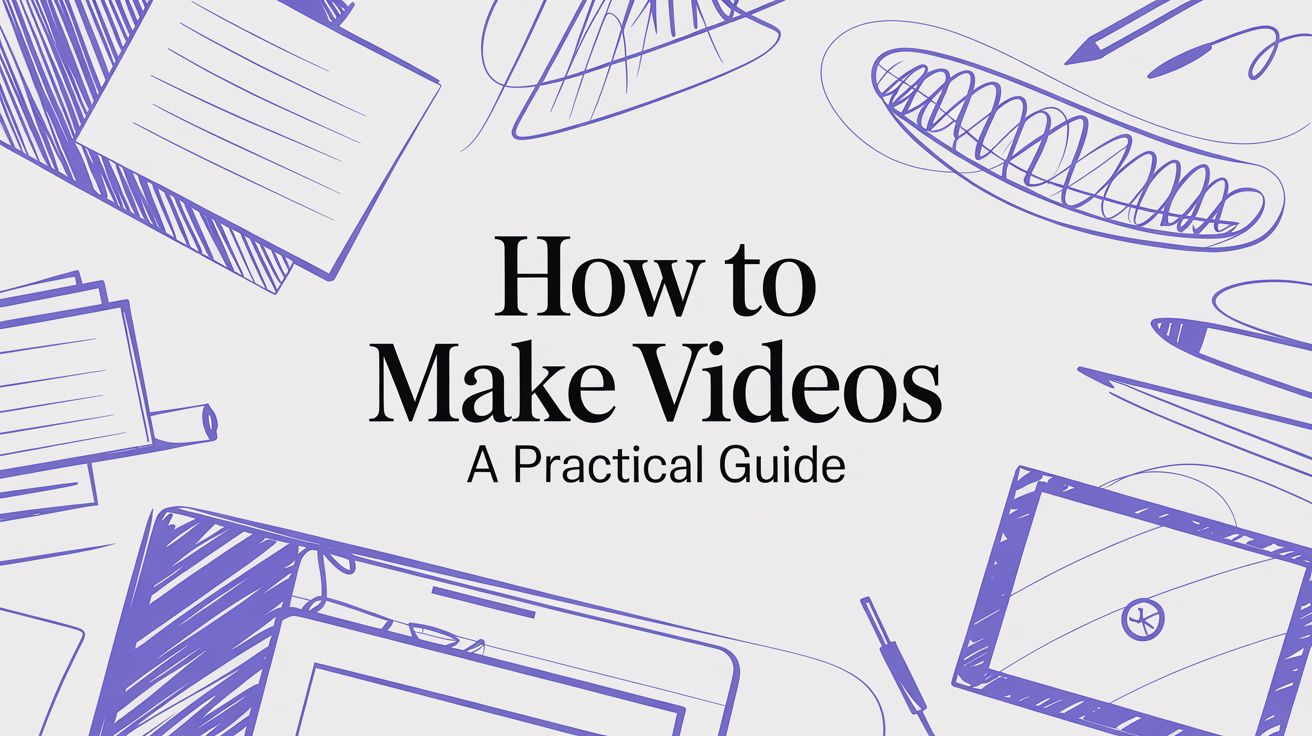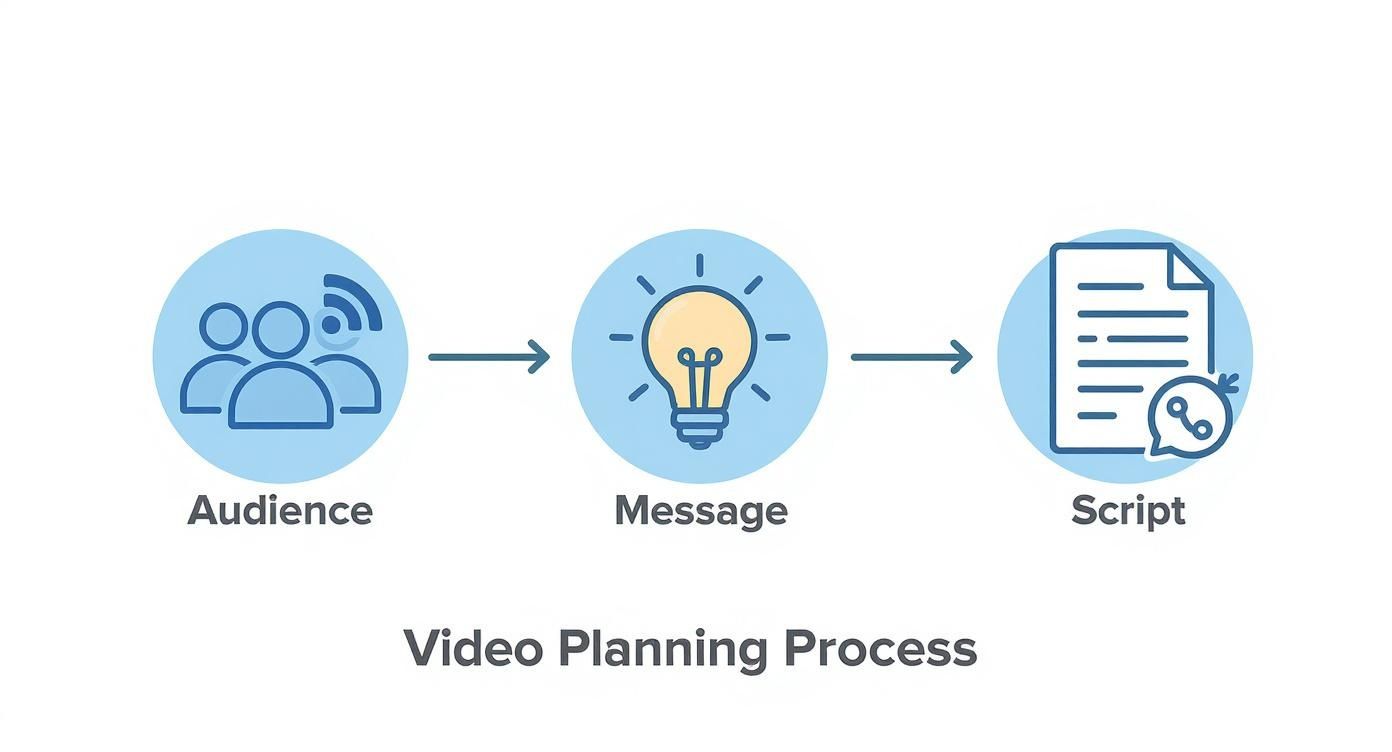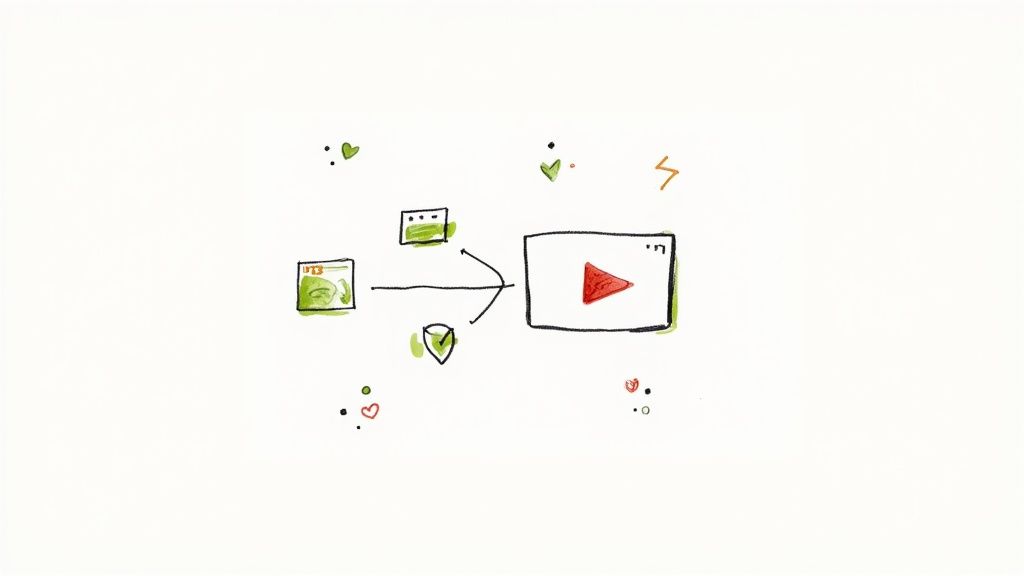How to Make Videos A Practical Guide

If you've ever felt intimidated by the idea of making videos, you're not alone. But at its core, it’s really just about telling a good story with pictures and sound. Once you learn how to make videos, you open up a whole new world of ways to connect with people and grow your audience.
Why Mastering Video Is a Creator's Superpower

Think about it: people spend hours every day watching content that feels authentic and personal. If you can get a handle on what makes a video click, you’ll stand out from the crowd. Here are actionable reasons why video is crucial:
- Build a real community: Video is incredibly personal. It helps you forge connections that turn casual viewers into dedicated fans.
- Grow your revenue: The numbers don't lie. A staggering 96% of marketers see video as a direct path to better brand awareness and sales.
- Tell stories faster: A well-made video can explain a complicated idea in just a few seconds, something that might take pages of text to achieve.
The data backs this up. Research shows that by 2025, 89% of businesses will be using video as a key part of their marketing. And 95% of marketers already consider it essential, with 93% reporting a positive ROI from their efforts—seeing boosts in web traffic (82%), leads (88%), and sales (84%). You can read the full research about 2025 video marketing statistics for yourself.
How Video Opens Doors
Not too long ago, you needed an expensive studio and gear to make anything look professional. AI tools have completely changed the game. For instance, Verbatik gives you unlimited text-to-speech and voice cloning, letting anyone produce studio-quality audio in minutes.
Actionable insight: Learning video skills is one of the fastest ways to build your brand and boost revenue. Start by creating short, simple videos focused on solving one specific problem for your audience.
For a deeper dive into platform-specific tactics, check out our guide on creating engaging social media content. It's packed with tips for making short clips that keep your audience hooked.
Real-World Success Stories
This isn't just theory. Take Sarah, who grew her small bake sale business by shifting from local fairs to Instagram Live demos. Her story isn't unique.
- Tiny brand, big win: One small business I know saw a 30% spike in signups just one month after posting a single one-minute demo video.
- Nonprofit impact: A local charity created a 45-second film that pulled in 15,000 views and an extra $5,000 in donations.
These are perfect examples of how knowing how to make a simple video can turn a great idea into tangible results.
Moving Forward
Now that you see the power behind video, you’re ready for the fun part: making your own. Let's get into the practical steps, starting with how to plan and script your ideas into a solid blueprint.
Getting started with video is more accessible than ever, and your journey begins right now.
Building Your Video From the Ground Up
Great videos are never an accident. They’re the result of careful planning that happens long before anyone shouts "action!" or hits the record button. Think of it like building a house—you wouldn't start hammering without a solid blueprint. The most actionable first step in learning how to make videos is figuring out who you're talking to and exactly what you want to tell them.
So, who is your target audience? Get really specific here. Are you making something for busy parents who need quick tips, aspiring coders looking for deep dives, or fellow gardeners swapping secrets? Knowing this helps you nail the right tone and style. A complex tutorial for a seasoned programmer is going to feel completely different from a fun, punchy video for a total beginner.
Once you’ve got your audience in your sights, you need to lock down your core message. What’s the one single thing you want your viewer to remember after watching? Try to boil it down to a single sentence. This focus is what keeps your video from feeling random and ensures your main point actually hits home.
From Idea to Script
With your audience and message sorted, it's time to get scripting. And don't worry, you're not writing the next Hollywood blockbuster. The goal is to write like you talk. A conversational script feels genuine and helps you connect with your viewers on a personal level. And if you're starting from scratch with visuals, it's surprisingly easy to create a video from pictures, which is a fantastic way to build a simple visual story around your new script.
Here are a few actionable tips I've learned from writing dozens of scripts:
- Get to the point, fast: You’ve got about three seconds to grab someone's attention. Start with a hook—a sharp question, a surprising fact, or a bold claim.
- Trim the fat: Read your script out loud. Does any sentence sound clunky or go on forever? Shorten it. Be ruthless and cut anything that doesn't directly serve your core message.
- Think visually: As you write, make little notes about what should be on screen. Mention where you'll add specific graphics, B-roll clips, or text overlays. This little bit of prep makes the filming and editing process a thousand times smoother.
If you’re staring at a blank page and need a nudge, a dedicated tool can be a lifesaver. Using an AI-powered script writer, for example, can help you organize your thoughts and spit out a polished draft in minutes.
The AI Advantage in Pre-Production
Now for a pro tip that can give you a massive head start. Before you even touch a camera or set up a light, you can completely perfect your video's audio track. This is one of those workflow secrets that saves an unbelievable amount of time down the line.
With a tool like Verbatik, you can paste your final script right into its text-to-speech generator. This lets you hear exactly how your video is going to sound before you've recorded a single second of footage.
Honestly, this changes everything. You can tweak the pacing, adjust the tone, and get the delivery just right without the headache of doing endless vocal retakes. Even better, Verbatik has unlimited text to speech, so you can experiment and refine as much as you need. For that next-level touch, the voice cloning feature lets you create a unique AI voice that becomes part of your brand identity. Nailing down your audio first gives you a rock-solid foundation to build your visuals on top of, making the whole production flow that much more efficient.
Assembling Your Video Production Toolkit
Let's get one thing straight: you don't need a Hollywood budget to create professional-looking videos. The secret isn't in owning the most expensive camera, but in making smart choices with your gear. Whether you're shooting on a smartphone or a fancy DSLR, it's the fundamentals—good lighting and clean audio—that truly separate amateur clips from polished, engaging content.
So, let's talk about building your toolkit.
First up, lighting. You can have the best camera in the world, but if your lighting is bad, your video will look flat and cheap. The good news? You don't need a complex three-point lighting setup. The best light source is often free: a large window with natural daylight.
If you're filming inside or at night, a simple ring light or a single softbox can make a world of difference. They create a flattering, professional look without casting harsh shadows. The goal is always soft, diffused light that makes your subject pop.
Sound Is Half the Battle
Now for the part that everyone overlooks: audio. I can't stress this enough. Viewers might forgive a slightly shaky camera, but they will click away in a heartbeat if the audio is muffled, tinny, or full of distracting background noise.
Your camera's built-in mic? It’s just not going to cut it for clean sound. A simple lavalier microphone that clips onto your shirt is a massive and inexpensive upgrade. But for narration and voiceovers, AI is the real game-changer.
Forget about soundproofing your room or buying a high-end studio mic. You can perfect your audio after you've filmed. This is where a tool like Verbatik comes in, as Verbatik has unlimited text to speech and voice cloning to create flawless, broadcast-quality voiceovers right from your script.
Before you even think about gear, though, your plan is what matters most. This infographic breaks down the core elements perfectly, from figuring out your audience to nailing down your script.

A successful video is always built on a solid strategy. Once you have that, you can pick the right tools for the job.
Essential Gear for Different Budgets
Picking the right gear can feel overwhelming, but it doesn't have to be. Your budget will dictate your choices, but you can get fantastic results at any level. Here’s a breakdown of what I’d recommend for different stages.
| Equipment | Beginner (Under $200) | Intermediate ($200 - $800) | Advanced ($800+) |
|---|---|---|---|
| Camera | Your Smartphone | Entry-Level DSLR or Mirrorless (e.g., Canon M50, Sony a6400) | Pro Mirrorless or Cinema Camera (e.g., Sony A7S III, Blackmagic Pocket 6K) |
| Microphone | Clip-on Lavalier Mic (e.g., BOYA BY-M1) | USB Mic (e.g., Blue Yeti) or Shotgun Mic (e.g., Rode VideoMic) | Professional Shotgun Mic (e.g., Sennheiser MKH 416) + Audio Interface |
| Lighting | Natural Light (Window) + Small Ring Light | LED Panel Light Kit (e.g., Neewer 2-Pack) | Aputure Light Dome or other professional softboxes |
| Tripod | Basic AmazonBasics Tripod or a GorillaPod | Manfrotto Compact Action or a fluid-head tripod | Heavy-duty video tripod (e.g., Sachtler or Manfrotto Nitrotech) |
As you can see, you can get started for less than the price of a nice dinner out. The key is to invest in audio and lighting first—they’ll give you the biggest bang for your buck.
Embracing Modern Production Tools
The video production world is exploding right now. It was valued at around USD 297 billion in 2024 and is projected to climb to USD 306.5 billion by 2025. This isn't just big studios; this growth is all about technology making production easier for everyone.
In fact, studios are already leaning heavily into AI, with 48% using it for editing and effects to speed up their work. You can learn more about these film and video production market findings and see just how fast things are changing.
This is great news for independent creators. Your toolkit is no longer just physical gear. It's now a blend of hardware and powerful software.
Adding the right audio cues, for example, can completely change the feel of your video. Instead of searching for hours for the right sound, you can explore libraries of AI-generated sound effects to find the perfect fit in seconds. By combining affordable gear with smart software, you have everything you need to start creating videos that look and sound incredible.
Bringing Your Video to Life in Post-Production
Okay, so you've got your raw footage. Now the real magic happens. Post-production is where you take all those separate clips and weave them into a story that actually connects with people. This isn't just about knowing which buttons to click; it's about making creative choices that pull your viewer in.
Think of yourself less as a "video editor" and more as a storyteller. Your first job is to be a ruthless curator. Go through every take and find the absolute gems. Don't get emotionally attached to your footage—if a clip doesn't serve the core message, it has to go. Cut, cut, and cut some more.
A simple trick I use all the time is the "jump cut." This just means trimming out the dead air, the "ums" and "ahs," or the little stumbles within a single shot. It instantly tightens up the pacing and makes you sound way more confident. It’s a small thing that makes a huge difference in holding attention.
Crafting a Narrative in the Edit
Once you’ve cherry-picked your best takes, it's time to build your timeline. And please, don't just dump them in chronological order and call it a day. Think about the emotional arc you want to create.
- Hook 'em Fast: The first 3-5 seconds are everything. Start with your most visually stunning shot, a provocative question, or a bold statement that makes them want to know what's next.
- Build the Core: The middle section is where you deliver the goods. This is the perfect place to sprinkle in B-roll—those extra shots that visually explain what you're talking about. It breaks up the monotony of a talking head and makes the entire video more dynamic.
- Stick the Landing: Your ending needs to feel intentional and powerful. Wrap it up with a clear call to action or a final thought that lingers with the viewer long after they've clicked away.
This simple framework transforms a random collection of clips into a real story with a beginning, middle, and end. Trust me, your audience will notice.
Mastering Your Audio with AI
If there’s one thing that screams "amateur," it's bad audio. You can have the most beautiful 4K footage, but if your sound is echoey, muffled, or inconsistent, people are gone. While audio cleanup tools can help, the absolute best way to get pristine sound is to create it perfectly from the start using your script.
This is where a tool like Verbatik completely changes the game for post-production. Instead of fighting with a noisy recording, you can generate a flawless voiceover directly from your text script.
Because Verbatik has unlimited text to speech, you can generate and tweak your narration over and over until it's perfect—without ever having to re-record a single word. You can dial in the pacing, the emphasis, and the tone, saving hours of frustration.
Want to maintain that personal touch? Its voice cloning feature is a genuine game-changer. You can create a unique AI version of your own voice. Imagine getting a perfect, studio-quality read of your script, in your voice, in just a few minutes. If you want a deeper look, check out this guide on how to add text to speech to videos.
Adding the Final Polish
With your story locked in and your audio sounding crisp, it’s time for the finishing touches. These are the layers that take a video from "good" to "wow."
- Music: The right background track is a powerful tool for setting the mood. Find some royalty-free music that matches the energy you're going for, whether it's upbeat and exciting or calm and thoughtful.
- Sound Effects (SFX): Little sounds make a big difference. A subtle "swoosh" when text appears or a "click" sound effect can make your video feel more alive and professional. Just don't overdo it.
- Color Correction & Grading: This is where you can really define the visual vibe. Start with color correction to make sure the footage looks natural (whites are white, skin tones look right). Then, move on to color grading to apply a specific style—maybe warm and inviting, or cool and cinematic.
- Graphics and Text: Use titles, lower thirds, and on-screen text to highlight key information and guide the viewer's eye. Just make sure your graphics are clean, on-brand, and super easy to read.
Each of these elements adds another layer of polish. When you combine them thoughtfully, you transform that pile of raw footage into a professional video that truly connects.
Sharing Your Video for Maximum Impact

You've done the hard work—the planning, shooting, and editing. But making a great video is just the first part of the equation. Now, it’s time to get it in front of the right people. This is where strategic distribution turns all your effort into actual views, engagement, and results.
A video's first impression is everything, and it all starts with how you package it. Think of your title as a hook, not just a label. Pair it with a keyword-rich description and a custom thumbnail that actually pops off the screen, and you’ve just created an irresistible reason for someone to click.
Optimizing for Every Platform
Each social media platform is its own world with its own rules. To look professional, you've got to play by them. Exporting your video with the right settings is a must. A classic 16:9 widescreen format is perfect for YouTube, but a vertical 9:16 aspect ratio is absolutely non-negotiable for TikTok and Instagram Reels.
To really get the most out of your content, you need to understand smart social media cross-posting strategies. This isn't just about blasting the same video file everywhere. It's about tailoring the length, captions, and even the tone for each specific channel.
Actionable Takeaway: Don't just upload and hope for the best. Be deliberate. Optimize your title, description, thumbnail, and format for each platform to give your content the best possible chance to succeed.
Captivating Viewers with Storytelling
Technical specs are important, but what truly keeps people watching is a powerful story. Just look at what's popular. Genres like fantasy and sci-fi dominated the video production market, pulling in over 27.5% in 2022. Why? Because they are masters of visual storytelling and special effects. With the consumer segment making up a massive 67.0% of end-use revenue, it's crystal clear that content for individuals has to be engaging.
You don't need a Hollywood budget to borrow these ideas. Build a little suspense. Use music to guide the emotional journey. Make sure your message has a clear, satisfying payoff. The narration itself is a huge piece of this puzzle.
And that's where AI can give you a serious advantage. Instead of spending hours recording audio, you can perfect your script's delivery with an AI voice. With Verbatik, you get access to unlimited text-to-speech and voice cloning, letting you craft the perfect narrative tone that hooks your audience from the very first second. For anyone creating promotional content, this is a game-changer. You can check out our guide on how to create video ads to see just how much seamless audio can elevate your final product.
Common Questions About Making Videos
Diving into video creation for the first time? You've probably got a few questions bouncing around your head. Let's clear up the common hurdles that trip up new creators so you can move forward with confidence.
Think of this as your cheat sheet to sidestep the usual frustrations and streamline your workflow right from the start.
What Is the Best Video Editing Software for Beginners?
The sheer number of editing programs out there can be paralyzing when you're just starting. The trick is to find a tool that's powerful enough for what you need but won't require a month of tutorials just to learn the basics.
For anyone new to editing, I always recommend starting with tools like DaVinci Resolve (which has an incredible free version) or CapCut. Both give you all the essential features you need without the overwhelming complexity of the pro-level stuff.
When you're ready to level up and maybe invest a little, industry powerhouses like Adobe Premiere Pro and Final Cut Pro are waiting. Your best bet is to pick one based on your budget and where you see yourself going with video in the long run.
How Can I Get Professional Audio Without Expensive Gear?
This is a big one. Here's a secret from someone who's seen it all: audiences will tolerate a slightly shaky camera, but they will click away in a heartbeat if the audio is bad. Luckily, you can get massive improvements in your sound with just a few simple tweaks.
First, your recording space matters. Find a quiet room with soft surfaces—think carpets, curtains, or even a closet full of clothes—to absorb echo and background noise. Even a cheap lavalier mic clipped to your shirt is a monumental upgrade over your camera or phone's built-in microphone.
But if you want perfectly clear, broadcast-quality narration every single time, AI is the game-changer. A tool like Verbatik gives you flawless voiceovers without needing any mics or soundproofing. It offers unlimited text-to-speech and even voice cloning, putting you in complete control of your audio.
How Long Should My Videos Be?
There’s no magic number here—the right video length is all about the platform you're posting on and what your audience expects.
But there are some solid rules of thumb that I've seen work time and time again:
- For TikTok or Instagram Reels: Keep it short and snappy. You're aiming for the 15-60 second range to hold attention.
- For YouTube explainers or tutorials: Content in the 8-15 minute sweet spot tends to do really well with engagement and the algorithm.
The golden rule is to deliver value and keep things tight. Never drag out a video just to make it longer. Your analytics are your best friend here; check to see where people drop off and use that data to make your next video even better.
What Are the Biggest Mistakes New Creators Make?
If you can dodge the most common mistakes, you’ll grow so much faster. I constantly see new creators stumble on the same three things: bad audio, poor lighting, and no plan.
We've already talked about audio, so let's hammer it home: prioritize clean sound above almost everything else. Next up is lighting. You don't need expensive gear; just face a window and use that beautiful, free natural light. It makes a world of difference.
Finally, never, ever hit record without a plan. It doesn't have to be a word-for-word script, but a simple outline will save you hours of headaches in the edit. Planning ahead is what separates sloppy content from a polished, professional video.
Ready to create flawless voiceovers and elevate your video's audio quality? With Verbatik, you can access unlimited text-to-speech, clone your own voice, and generate royalty-free music and sound effects. Start creating professional audio today at Verbatik.
